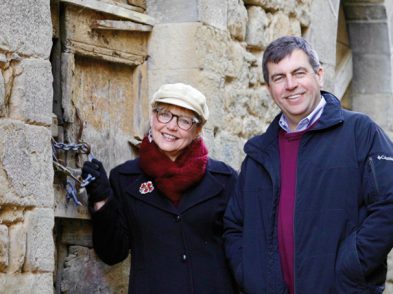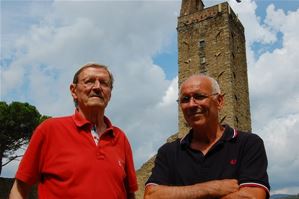In 1975, the chance discovery of a secret underground chamber beneath the Medici Chapels led to an even more stunning revelation: 400-year-old graffiti that provides an insight into what seems to have been the most turbulent period of Michelangelo’s life—the 30 days of fear, hunger and boredom he spent while hiding from the wrath of the vengeful Medici.
At the time of the discovery, the then director of the Medici Chapels, Paolo Dal Poggetto, was contemplating the difficult task of creating an emergency exit for the new sacristy. The museum custodian pointed out that perhaps the solution lay in a small room to the left of the altar. As the area was cleared of furniture, a trapdoor was discovered. Not only did it lead to a small underground chamber but when the lime rendering was removed from the walls, a set of charcoal sketches came to light. These were later attributed to Michelangelo. As it turns out, the outer layer of lime, which was probably applied to cover the drawings, preserved them.
So, what was Michelangelo doing down in that underground little cell?
In 1527, the Florentines ousted the Medici rulers and proclaimed the Republic of Florence. At the time, Italy was plunged in a bitter war that saw the imperial Spanish army of Charles V pitted against the French and their ally, the pope. The Florentine Republic sided with the French, but when the Spanish gained victory, both the French and the pope signed treaties with Charles and left Florence to its own devices. In a dramatic twist of allegiance, the pope sent an army to bolster the Spanish forces. He schemed the defeat of the Florentine Republic in order to install his nephew, Alessandro de’ Medici, as ruler of the city.
Florence was besieged for 10 months, from October 1529 to August 1530. Fifty-four-year-old Michelangelo, who was already recognized not only as one of the foremost artists of the time but also a specialist of fortifications, was nominated general governor and procurator of the fortifications of Florence, which he set out to strengthen and improve. However, when the Florentine army was heavily defeated in August 1530 at Gavinana, the beleaguered Florentines knew that the days of the republic were counted. The city surrendered soon after.

The triumphal return of the Medici rulers to Florence spelled disaster for those who had supported the republic. Michelangelo’s own fame made him a marked man. With the help of a friend, perhaps the prior of the Medici Chapels, Michelangelo hid in an underground chamber beneath the new sacristy of the Basilica of San Lorenzo—a place he knew well, having worked there both as an architect and as a sculptor. He hoped to escape from the vengeance of the Medici by hiding right under their noses.
It is thought that Michelangelo spent a month secluded in that chamber, with only a tiny window as a link to the outside world. The days must have seemed endless to a man of his energy, and boredom must have struck him hard. Perhaps he even suffered hunger, but undoubtedly he must have lived those days in constant fear of the fate that awaited him should he be discovered.
In his moments of despair, Michelangelo gave voice to his thoughts by sketching on the walls with a piece of charcoal. The sketches include thoughts about the David, who had become the unofficial symbol of the Florentine Republic, and a convolution of bodies that resembles those of the Last Judgment later frescoed on the altar wall of the Sistine Chapel. A haggard, hunched figure scribbling on parchment with a quill could be a self-portrait, reflecting the artist’s state of mind during those lonely, miserable days. Of particular interest is the study of a hand with the finger poised outwards, which is reminiscent of God tending his hand to Adam on the ceiling of the Sistine Chapel, as well as the sketch of a man’s knees that probably served as a blueprint for the sculpture of Duke Giuliano de’ Medici’s memorial statue, which Michelangelo would later sculpt and now stands in the hall above the same chamber.
Pope Clement VII, restored to power, eventually wrote a letter of pardon for Michelangelo and ordered him to continue working on the chapel at San Lorenzo. The pope needed the services of the foremost sculptor in Italy to boost the prestige of the Medici dynasty.
The secret chamber under the Medici Chapels is not accessible to the public, but Michelangelo’s sketches can be viewed on touchscreen monitors in three locations: Bargello National Museum, Accademia Gallery and the Sagrestia Nuova in the San Lorenzo complex.






